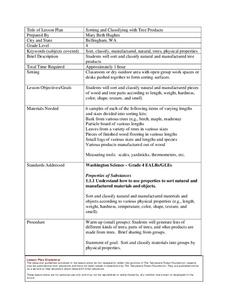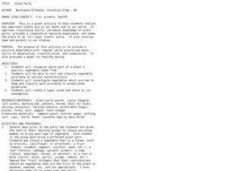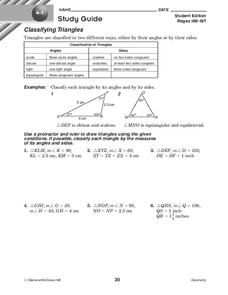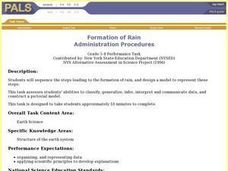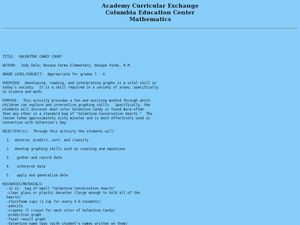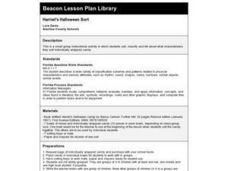Curated OER
Sorting and Classifying with Tree Products
Fourth graders sort and classify wood. In this sorting tree products lesson, 4th graders sort and classify tree parts and pieces of wood, both natural and manufactured according to their properties.
Curated OER
Saving Makes Cents
Students identify ways families save money. For this financial lesson, students read the book A Chair for My Mother and discuss ways to save money. Students identify coin values and practice counting money.
Curated OER
Vegetable Party
Students classify vegetables and eat them as a salad. In this multi-disciplinary science and health lesson, students bring various vegetables to school and classify them in several different ways. Then with parent helpers, the students...
Curated OER
Lesson 1: Hot, Not, or Silly
Students discover burn prevention and fire safety while sorting and classifying related pictures. In this early childhood lesson plan, students identify ways to prevent burns, and discuss various ways in which burns may occur. Students...
Curated OER
Classifying Triangles
In this classifying triangles worksheet, 10th graders solve 12 different problems that include classifying various types of triangles. They classify and then identify each of the given triangles as isosceles, scalene, or equilateral....
Curated OER
Line Symmetry
In this line symmetry worksheet, 10th graders solve and complete 10 different problems that include various types of figures. First, they classify each figure illustrated as horizontal, vertical, both, or neither line of symmetry. Then,...
Curated OER
Classifying and Measuring Angles
In this classifying and measuring angles worksheet, 10th graders solve and complete the measures of various types of angles. They determine whether each angle drawn is a straight, right, obtuse, acute, or reflex angle. Then, students...
Curated OER
Classifying Triangles
For this classifying triangles worksheet, 10th graders solve 9 various problems that classify triangles into categories. First, they refer to the figure shown of an isosceles triangle with two line parallel. Then, students name the...
Curated OER
Classifying Triangles
In this classifying triangles worksheet, 10th graders solve 6 different problems related to the classification of triangles either by their angles or by their sides. First, they use a protractor and a ruler to draw triangles using the...
Curated OER
Bivalve or Univalve (Clam or Snail)?
Fourth graders explore the meaning of the prefixes "bi" and "uni." In groups, 4th graders observe pictures of shells and handle real shells. Students create a chart to classify each shell as a bivalve or univalve. They identify the...
Curated OER
Living vs. Non-Living Things
Fourth graders describe the characteristics that determine if something is living, dead, or non-living. They determine the difference between living and non-living things. Students determine if an object is living or non-living and...
Curated OER
Suspended Particulates lab
Students observe differences between suspended particulates and a solution, and classify common atmospheric gases and particulates. They explain what they think the word suspended means. Students observe the differences between what...
Curated OER
Where Do Animals Live?
Students c;assify where pets live and where wild animals live and comprehend the differences. They investigate what kinds of homes pets and wild animals need. Students bring in a stuffed animal or puppet from home and match their...
Curated OER
Classification of Animals
First graders investigate the characteristics of vertebrates. They classify each as mammal, fish, bird, and reptiles. Students explore the differences between various types of animals and classify each.
Curated OER
Introduction To the Classification of Organisms
Students discuss how scientists classify organisms. In pairs, they analyze and label "specimens" of breakfast cereals in order to classify them into the correct group. They create a dichotomous key for several species of animals.
Curated OER
Formation of Rain
Students sequence the steps leading to the formation of rain, and design a model to represent these steps. This task assesses students' abilities to classify, generalize, infer, interpret and communicate data, and construct a pictorial...
Curated OER
Formation of Wind
Young scholars correctly sequence the steps leading to the formation of wind, and describe the cause and effect relationships involved in the formation of wind. This task assesses students' abilities to classify, generalize, infer,...
Curated OER
Critter Museum
Students act as directors of a new science museum where they have decided to set up a display of animals without backbones that are found in the area. To organize their display, they need to sort and classify a collection of animals and...
Curated OER
What are Mammals?
Pupils differentiate between wild and tame animals, explain how to classify mammals into groups based on common charactertistics and comprehend the values of zoos. They listen as the teacher reads Psalm 50:10 and explains that all of the...
Curated OER
Classification
Students gather and classify samples of a given item (rocks, fossils, seeds, etc.) They discuss various ways of classifying and that there are many different ways that are acceptable.
Curated OER
A Planet Full of Animals
Students explore a variety of animals that live on our planet. The shapes, sizes, colors, movements, and coverings of the animals are observed. The similarities and differences in the animals are grouped according to common traits.
Curated OER
Classification And Identification
Pupils explore diagrammatic and taxonomic keys and their application in the marine sciences. They sort and classify objects and organisms based on visual attributes.
Curated OER
Valentine Candy Count
Students investigate what color Valentine Candy is found more often than any other in a standard bag of "Valentine Conversation Hearts." They sort, classify and graph their findings.
Curated OER
Harriet's Halloween Sort
Young scholars listen to the book, Harriet's Halloween Candy, and discuss the many ways Harriet sorted the candy from her trick-or-treat bag. They sort and classify individually wrapped candy.


